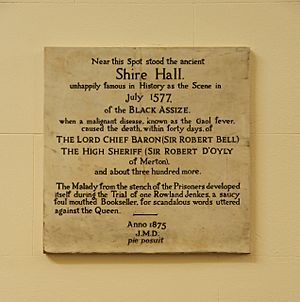Black Assize of Oxford 1577 facts for kids
The Black Assize was a terrible event that happened in Oxford, England, in the summer of 1577. Many people died between July 6 and August 12. About 300 people, including important leaders like the chief judge and the sheriff, passed away. It got its name because it was linked to a court trial held at Assize Court at Oxford Castle. People believed a mysterious illness or even a curse caused these deaths.
Contents
How Many People Died?
Reports about how many people died in the "Black Assize" are a bit different. In Oxford itself, about 300 deaths are always mentioned. But some reports say even more people died outside the city. One old report says:
'There died in Oxford 300 persons, and sickened there, but died in other places, 200 and odd, from the 6th of July to the 12th of August, after which day died not one of that sickness, for one of them infected not another, nor any one woman or child died thereof.'
This report also noted that no women or children died from this sickness. This made people wonder what really caused so many deaths.
What Caused the Black Assize?
On a wall inside the Old County Hall of Oxfordshire in New Road, there is a special message. It talks about the Black Assize:
Near this spot stood the ancient Shire Hall, unhappily famous in history as the scene in July 1577 of the Black Assize, when a malignant disease known as Gaol Fever caused the death within forty days of the Lord Chief Baron of the Exchequer, Sir Robert Bell, the Lord High Sheriff (Sir Robert D'Oyly of Merton) and about three hundred more.
The malady from the stench of the Prisoners developed itself during the Trial of one Rowland Jenkes, a saucy foul-mouthed Bookseller, for scandalous words uttered against the Queen.
Anno 1875. JMD pie posuit. (Year 1875. JMD piously erected [this monument].)
The Sickness Theory
From the 1300s until the late 1800s, Oxford often faced outbreaks of serious diseases. These included the plague, cholera, smallpox, and typhoid fevers. For example, in 1348, the Black Death caused so many deaths that a college had to close.
In 1571, Oxford University even had to delay the start of classes because of a plague outbreak. The "gaol fever" that happened six years later might have been part of the same widespread sickness. It was especially noticed because important people like the chief judge and the sheriff died.
Many old writings support the idea that a disease caused the deaths. One early record says:
'The Court were surprised with a pestilent savour, whether arising from the noisome smell of the prisoners, or from the damp of the ground, is uncertain; but all that were present, within forty hours died, except the prisoners, and the women and children; and the contagion went no farther.'
A writer in the 1800s was more certain about the cause:
'The assize held at Oxford in the year 1577, called the "Black Assize," was a dreadful instance of the deadly effects of the jail fever. The judges, jury, witnesses, nay, in fact every person, except the prisoners, women and children, in court were killed by a foul air, which at first was thought to have arisen out of the bowels of the earth; but that great philosopher, Lord Bacon, proved it to have come from the prisoners taken out of a noisome jail and brought into court to take their trials; and they alone, inhaling foul air, were not injured by it.'
This idea suggests that the sickness came from the unhealthy conditions of the prison.
The Curse Theory
However, some people did not believe it was a disease. They thought something else caused the deaths. One story tells of a man named Rowland Jenkes. He was on trial for saying bad things about the Queen.
According to this story, Rowland Jenkes had a special "wick" or "candle" made. It was said to be very poisonous. The story claims that as soon as he was found guilty, he lit this wick. People believed that the smoke from this wick caused the deaths.
Other stories simply say that Rowland Jenkes put a curse on the court. They believe this curse was the reason so many people died.
Black Assize in Popular Culture
The Black Assize is often shown at Oxford Castle. It is also a popular story on Oxford ghost tours. On these tours, the tale of Rowland Jenkes' curse is often highlighted.
The events of this time are also part of the historical crime novel Heresy by S. J. Parris. In this book, Rowland Jenkes appears as a character.
See also
Sources
- This article incorporates text from the public domain 1907 edition of The Nuttall Encyclopædia.


